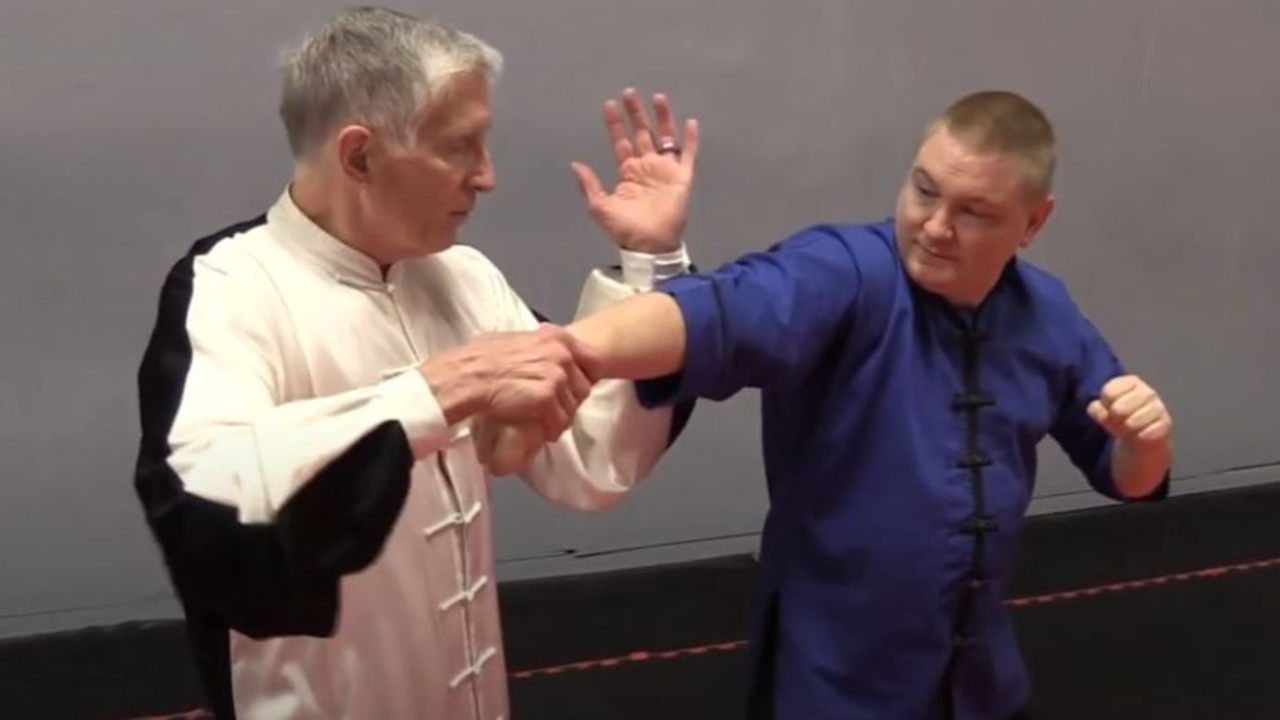Four Takedowns from Four Tai Chi Movements

Here is a short video showing and explaining some of the body mechanics to four takedowns in four different movements from Chen style Taijiquan.
I am fascinated at all the self-defense applications in movements that often appear slow and gentle. Taiji (Tai Chi) is practiced slowly to develop proper internal body mechanics. There is a method of developing skill that later involves push hands, then flowing with a partner in unscripted ways, and then incorporating joint locks, sweeps, takedowns, elbow and shoulder strikes and other fighting techniques.
The takedowns come from these four movements:
- Lazy About Tying the Coat
- Walking Obliquely
- Punch the Ground
- Single Whip
Enjoy this video. We shot in on Sunday and I edited it today. Let me know if you have questions.
What Does "Double-Weighted" Mean in Tai Chi?
You have heard people say that being "double-weighted" is bad in Taijiquan.
But if you ask 10 different Taiji folks what that means, you will get 10 different answers.
Some say it is when your weight is distributed 50-50 between the legs.
Some say it's a mental thing. Others say something completely different.
This video shows what I learned about double-weighting from training with Chen Xiaowang, Chen Xiaoxing and their students and disciples.
What Does Being "Double-Weighted" Mean in Tai Chi?

Has a Taiji teacher ever explained to you what "double-weighted" means? It's bad to be double-weighted, but if you are looking for a definition of the term, you will find a lot of them out there. Most of them are wrong.
Some will tell you that you are double-weighted when your weight is distributed 50-50 between the legs.
Others will say something else.
The video below demonstrates what I learned about being double-weighted from Chen Xiaowang, Chen Xiaoxing and their students (my teachers).
Close-Up Self-Defense Using Tai Chi Energies and Methods: DVD

You are in a situation where you cannot escape a fight. Someone your size or larger lunges at you, grabs you in a clinch, and tries to take you to the ground.
Can you use your Tai Chi skills to take HIM to the ground instead?
I have been working on this since 2006, when I was practicing push hands with Chen Xiaoxing in my basement and he kept putting me on the ground -- over and over again -- and he did it so easily, I could not understand what he was doing until about the tenth time I found myself on my back.
He was breaking my structure and controlling my center.
The insights from that training have driven me for the past dozen years to explore how to use the "energies" of Tai Chi (Taiji) for close-up self-defense.
How do you use ward-off, roll back, press, push, split, pluck, bump, elbow, empty, advance, withdraw in a real fight? How do you use these methods of dealing with force to take your opponent to the ground without using muscular force or "wrestling?"
My new DVD answer...
Teaching My Wife How To Do A Tai Chi Takedown with Split Energy

My wife, Nancy is my videographer. She is usually behind the camera as we record lessons for DVDs and the website.
Yesterday, as we were recording some tuishou instruction about using tai chi "energies" and methods to do takedowns, we pulled her out in front of the camera to learn how to do a takedown using "shoulder" energy.
I enjoy teasing Nancy. She has a great sense of humor. One of the reasons I started in martial arts was because I thought it was fun. I still do, so I often include outtakes and jokes in my DVDs and video for the website.
This is a short video showing Nancy learning a good technique. The Chinese term for the technique is at the end.
10 Quick Ways to Break or Lock an Elbow with Chin-Na Joint Locks

Most traditional martial arts styles give names or numbers to joint-locking techniques. In Chinese chin-na (also spelled qinna), we have names such as "Half Moon," or "Push the Boat Down the Stream." I have always loved these descriptive, poetic names, but sometimes they get in the way.
The best way to learn chin-na is not to memorize names and techniques. The best way is to look at principles -- look at the way joints move -- and then do free-flowing sparring exercises and push hands to practice recognizing opportunities for joint locks when they arise in a fight.
IMPORTANT RULE FOR CHIN-NA:
When someone attacks you, you will NEVER be able to say, "I'm going to get that guy in an Outside Wrist Twist." If that is what you are planning, he will probably knock you out while you are looking for your opportunity.
The best plan is no plan. And that is what practice is for.
You practice with this goal in mind: you want to be able to recognize opportunities for joint locks that arise dur...
Is Your Martial Art Preparing You for Real-Life Self-Defense?

What is real-life self-defense? What is real-life self-defense with the internal arts?
Do I need to step into a ring and go full-contact these days to prove myself?
Do you?
There are suddenly a lot of keyboard warriors out there who seem to think so. Personally, I have mixed feelings about it. I have always enjoyed fighting, but as an adult, I believe it is much better to learn how to fight without getting hurt and without hurting someone else.
When my 15-year-old student was grabbed by a drunk step-father who was preparing to punch him out, my student broke the step-father's elbow with chin-na we practiced in class. That's real-life self-defense.
When my student who is a police officer took a fugitive rapist down with Pi Chuan, a Xingyi technique, he didn't ask himself during the encounter if he was using internal energy just right. He simply took down the man who was considered dangerous.
When three drunk guys at a concert wanted to fight me, I remained centered and managed...
A 4-Step Plan for Defending Yourself with Taijiquan

Use Tai Chi Pluck Energy for Real Self-Defense

There are many different "energies" in Tai Chi and the internal arts. Cai energy is also called "Pluck." It is a sudden pulling action that can take your opponent off-balance.
Pluck can be done in a subtle way in push hands but in real self-defense, when your life can be in danger, it is not subtle and not especially pretty -- but it is definitely effective and it can be used against all kinds of attacks.
Here is how to begin practicing this particular method of Tai Chi Pluck energy. Have a partner attack you without warning. Your first goal is to cover and block the attack. Instinctively, you should drop your weight and avoid the lifting of the body. This takes a lot of practice and presence of mind. In fact, it is a very good idea simply to react to an initial attack by practicing -- over and over -- the dropping and covering technique to protect yourself in the event of a surprise attack.
Despite what ...
A Hidden Neck Break in Hidden-Hand Punch

I am fascinated by the self-defense applications of Chen Taijiquan. There are no transitions, no "wind-ups" to self-defense techniques. Every action in a Tai Chi form is a fighting technique.
I recently published an ebook with 239 photos demonstrating and explaining more than 100 self-defense applications of the Chen 19 form (click here to find the ebook on Amazon). In 2008, I did a 3-DVD set demonstrating more than 400 fighting applications in Laojia Yilu. All of my DVDs go deeply into the self-defense applications of each form I do in Taiji, Xingyi or Bagua. In my view, the true intent of these movements is contained in the self-defense applications. There are people who disagree with me, but in my opinion you simply can't do the form well if you don't understand how it feels to use the movements against an attacker. That's what they were created to do.
The photos here show the first appearance of the movement "Hidden Hand Punch" in the Chen 19 form -- the short form created by ...
